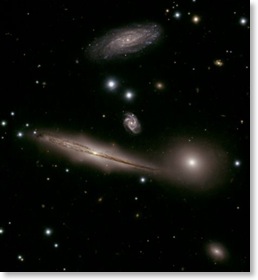Galaxy Clusters
(This article has been reproduced from the Center for Scientific Creation. The original article can be found here.)Hundreds of rapidly moving galaxies often cluster tightly together. Their relative velocities, as inferred by the redshifts of their light, are so high that these clusters should be flying apart, because each cluster’s visible mass is much too small to hold its galaxies together gravitationally.[a] Because galaxies within clusters are so close together, they have not been flying apart for very long.
A similar statement can be made concerning many stars in spiral galaxies and gas clouds that surround some galaxies.[b] These stars and gas clouds have such high relative velocities that they should have broken their “gravitational bonds” long ago if they were billions of years old. If the redshift of starlight always indicates a star’s velocity, then a multi-billion-year-old universe is completely inconsistent with what is observed. If redshifts can be caused by phenomena other than a star’s velocity, much of current astronomical thinking is wrong.
These observations have led some to conclude, not that the universe is young, but that unseen, undetected mass is holding these stars and galaxies together. For this to work, the hidden mass, sometimes called dark matter, must be 10–100 times greater than all visible mass, and the hidden mass must be in the right places. However, many experiments have shown that the needed “missing mass” does not exist.[c] Some researchers are still searching, because the alternative is a young universe.
Footnotes
a - “In 1933 the late Fritz Zwicky pointed out that the galaxies of the Coma cluster are moving too fast: there is not enough visible mass in the galaxies to bind the cluster together by gravity. Subsequent observations verified this ‘missing’ mass in other clusters.” M. Mitchell Waldrop, “The Large-Scale Structure of the Universe,” Science, Vol. 219, 4 March 1983, p. 1050.b - Faye Flam, “NASA PR: Hype or Public Education?” Science, Vol. 260, 4 June 1993, pp. 1417–1418.
• “It turns out that in almost every case the velocities of the individual galaxies are high enough to allow them to escape from the cluster. In effect, the clusters are ‘boiling.’ This statement is certainly true if we assume that the only gravitational force present is that exerted by visible matter, but it is true even if we assume that every galaxy in the cluster, like the Milky Way, is surrounded by a halo of dark matter that contains 90 percent of the mass of the galaxy.” Trefil, p. 93.
• Gerardus D. Bouw, “Galaxy Clusters and the Mass Anomaly,” Creation Research Society Quarterly, Vol. 14, September 1977, pp. 108–112.
• Steidl, The Earth, the Stars, and the Bible, pp. 179–185.
• Silk, The Big Bang, pp. 188–191.
• Arp, Quasars, Redshifts, and Controversies.
• Halton M. Arp, “NGC-1199,” Astronomy, Vol. 6, September 1978, p. 15.
• Halton M. Arp, “Three New Cases of Galaxies with Large Discrepant Redshifts,” Astrophysical Journal, 15 July 1980, pp. 469–474.
c - A huge dust ring has been observed orbiting two galaxies. The measured orbital velocity of this ring allows the calculation of the mass of the two galaxies and any hidden mass. There was little hidden mass. Statistical analyses of 155 other small galactic groups also suggest that there is not enough hidden mass to hold them together. [See Stephen E. Schneider, “Neutral Hydrogen in the M96 Group: The Galaxies and the Intergalactic Ring,” The Astrophysical Journal, Vol. 343, 1 August 1989, pp. 94–106.]
----------
(This article was taken from the book, In the Beginning by Dr. Walt Brown. The book can be purchased from the Center for Scientific Creation. The original article can be found online here. For more information about Dr. Walt Brown, click here).
